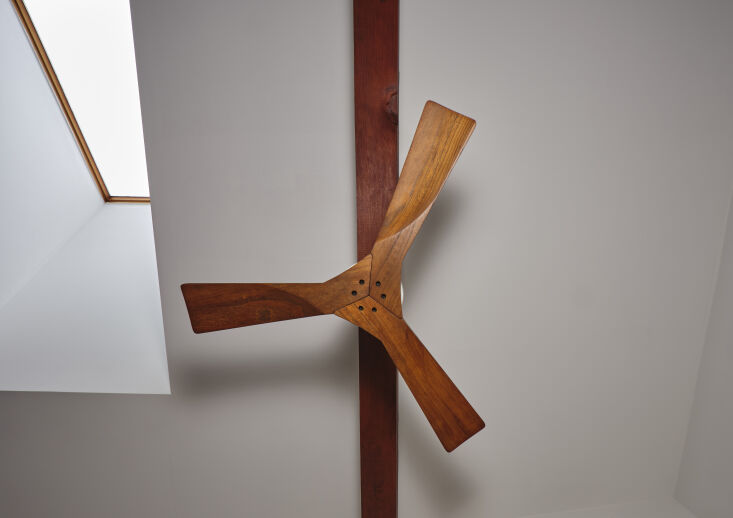Editor’s note: This is the latest in a series of posts by Sally Kohn— journalist and CNN political commentator, TED talk giver, and design aficionado—chronicling her adventures in remodeling. For earlier installments, see The Case for Unstained Wood Floors from a Stealth Design Nerd and The Surprising Virtues of Spray Paint (Plus a Few Tips), just to name a few.

When we lived in Brooklyn, we didn’t have central air conditioning so we were huge fans of ceiling fans, for understandable reasons. (And yes, this piece will be filled with puns; accept it.)
When we moved to the country, to a home that, blissfully, already had central air installed, we figured our days of ceiling fans were over. Not so fast. It turns out, since we live in a renovated barn with high ceilings, ceiling fans are still essential to circulate the A/C. And especially because summers are only getting warmer, the air conditioning has trouble completely cooling our rooms, making ceiling fans even more important.
But I’d only ever seen ugly ceiling fans, and moving into a historic home with beautiful exposed wood beams criss-crossing the ceiling, I was worried ceiling fans would drag the whole place down. The designer fans I’d used in the past were pretty but not exactly great at moving air. What’s a design-conscious fan of circulating air supposed to do?

I found my solution in two “Nan” model fans from the Matthews Fan Company. These are elegant three-blade fans that come in a variety of options. For instance, you can do the motor housing finish in brass or matte black or textured bronze, and the fan blades can be white or barn wood or gray ash. For us, white motor housings with walnut fan blades was perfect. The fans almost look like they were custom made for our home, set against our white ceilings and wood barn beams. They look elegant against the tall beamed ceilings of our barn home and are in a woody conversation with the round Tom Dixon fan chair and the Woud arc coffee table. A friend visiting quizzically gazed at the Nan XL fan in our living room and said, “That can’t be original, is it?”
But it wasn’t until the fans were installed that I really understood their magic. You see, most ceiling fans sold in the United States are AC fans. But if you spend a little more on a higher quality fan, you can get a DC model. No, it has nothing to do with which half of the heavy metal band you prefer. AC, or alternating current, fans are cheaper to produce but less efficient in terms of how much air they move for the energy they consume. And AC fan motors are generally bigger and heavier. On the other hand, DC, or direct current, fans can deliver more torque and accommodate bigger blades, packing more windy bang for the buck. “DC fans,” explains Matthews Fan Co. owner Chuck Matthews, “use approximately half the electricity to generate the same CFMs.”
CFMs? That stands for cubic feet per minute, a standardized measurement of how much air a fan can move. (Believe it or not, it wasn’t until 2017 that the federal government started regulating ceiling fans—but those standards just required things like a separate way to control the fan from the lights and an ability to change the fan speed. Did your fan move the amount of air the manufacturer promised? No real way to know, and certainly not across brands, until new regulations went into effect in 2020. Incidentally, I learned all this from the Air Movement and Control Association, which is a real thing.) Anyway, the point is DC fans are more expensive than AC fans but probably worth it.

But that’s not the only thing Chuck Matthews from Matthews Fan Co. taught me. And this next one is going to blow your mind (again, pun intended). I asked Chuck to explain to me how to know if my fan is spinning the right way during the summer versus the winter. And Chuck responded that there is no wrong way. I repeat, THERE IS NO WRONG WAY. Bbasically, do whatever feels good to you.
“An easy rule of thumb on the forward and reverse of ceiling fan usage: Ceiling fans circulate air. They either push a column of air upwards, towards the ceiling, or downwards, towards the floor,” Chuck explains. “So, if you want a breeze on you, have the blades pushing the air downward. If you don’t want a breeze, reverse the blades and have the column of air blow upwards towards the ceiling.”
Personally, I don’t want to admit how much time I’ve wasted standing under my ceiling fan wondering if it’s going clockwise or counterclockwise and then trying to figure out which way it’s supposed to be going, so then sitting down to Google which way it’s supposed to be going and then forgetting which way it’s currently going and then trying to figure that out from a totally different vantage point looking at the fan which is now upside down, right? Or am I suddenly upside down?
No, says Chuck, we’re all doing it wrong. The fan will move air either way. So just feel the air, and if you don’t like how the fan is making the air around you feel, change the direction. “Otherwise it’s just too complicated: clockwise, counter clockwise, summer, winter, forward, reverse.” Yes, Chuck. Yes, otherwise it is too complicated! Where have you been for the last 46 years I’ve spent cursing at ceiling fans?

In sum, beyond these two big headlines, do whatever you want. Get the traditional design. Get the funky design. Go with wood blades. Go with metal blades. Try one of those fans that feels like a prop from a scene in Casablanca. If you can get a DC model, and just pay attention to the feeling of the air and what setting works for you in the moment, I’m confident that whatever you purchase, you’ll be a fan.
For more fan intel, see 10 Easy Pieces: Wood Ceiling Fans.
(Visited 908 times, 908 visits today)


